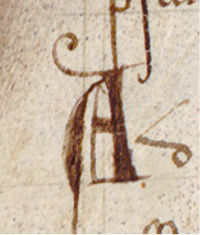The Solemn Privilege
In the solemn privilege Frederick II grants and confirms that Archbishop Eberhard of Salzburg did not reassign the vacant bailiwicks of (Reichen-)Hall, Petting, Saaldorf, Chiemgau and Sondergut, but that instead they will remain in his hands and the hands of his successors. (Regesta Imperii V/1 Nr. 1806typo3/)
Content was always the essence of each medieval charter, still the visual aspect especially of the “solemn privileges” should not be underestimated. The layout represents another function detached from the legal text: The privilege represents the monarch’s will and at the same time it symbolises his sovereignty, his „maiestas“.This was achieved by designing the document in a special way, particularly with a layout employing eye-catchers. Of particular importance here are the design of the monarch’s name in the upper section of the document as well as the so-called ruler’s monogram in the lower section of the privilege.
A number of distinguishing elements supports this central presentation of the monarch. If we journey back about 800 years, take into account the widespread illiteracy of that time and try to imagine a legal act like the formal handover of a privilege, it is easily comprehensible, that everybody present was above all aware of these elements and it was understood: The monarch is present through these symbols and monogrammatic references.
Description of Individual Sections

Chrismon
monogrammatic invocation (invocatio) of God: Chrismon
It is assumed that the use of this symbol can be traced back to St. Paul asking to begin all our doing in the name of God. In a simpler design, the Chrismon can be found already in the charters of the Merovingian kings but received its C-shape design not until the second half of the 9th century.

Elongata
extremely vertical and narrow type of script usually applied to the Protocol, especially the verbal Invocatio and the Intitulatio. For aesthetic reasons, the notary often tries to fill in the first line entirely. The Elongata follows the tradition of the Salian-Hohenstauffen charters.

Monarch’s Name
In a bold, capital-uncial mixed alphabet.
The central eye-catcher in the charter’s upper section – just like the monarch’s monogram in the lower section – can be traced back to the Sicilian-Norman charter tradition. The first character, the monarch’s initial, is often enlarged and richly decorated. The following characters’ arrangement one above the each other, just like in a gallery, does not appear until Frederic II’s emperor years.

Royal Monogram
(H- or N-shape); other characters are attached to the combining lines, this way the monarch’s name and title can be deduced. In this N-shaped symbol the characters A, C, D, E, F, G, H, I, L, M, N, O, P, R, S, T, U and V can be found and connected to „FRIDERICUS ROMANORUM IMPERATOR“. At the time of the Carolingians and the Ottonians the Monarch added his own finalising line (executive stroke) to the Royal monogram as a sign of his personal involvement, with the Stauffer monarchs this is no longer common.

Upper Case Letters
Marking paragraphs according to content or form sections.

Seal (Means of Authentication)
In the times of Frederic II there was only the „sigillum pendens“ (pending seal) left, mostly made of wax (on special occasions also made of gold = „Golden Bull“).

Signum Line
The signum line is part of the Eschatocoll and written, like the first line in Elongata, in an extremely narrow, vertical script. The Monarch’s Monogram is part of this line.
